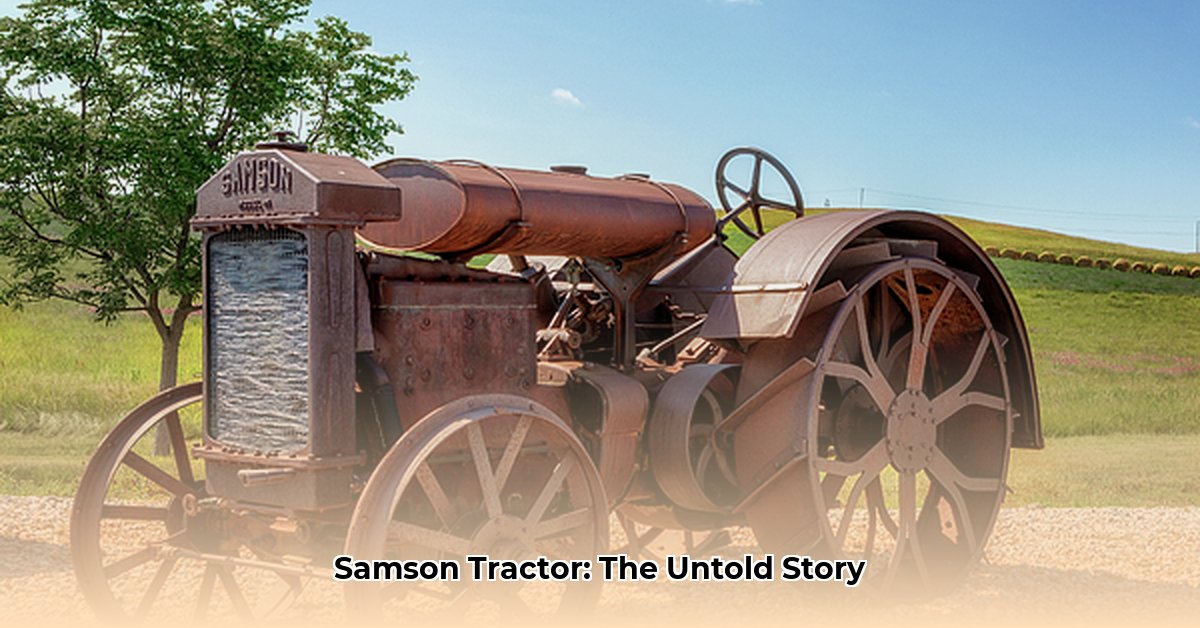
The Samson tractor, a product of General Motors' foray into agricultural machinery, offers a compelling case study in early 20th-century AgTech. Its story, marked by initial success followed by a rapid decline, provides valuable insights into the complexities of innovation, market dynamics, and the importance of strategic planning. This analysis examines the Samson's technological innovations, its market performance, and the crucial factors contributing to its ultimate failure, offering actionable lessons for modern agtech businesses. For more on early tractor history, see this great resource.
A Groundbreaking Design: The Samson's Technological Advantages
The Samson tractor differentiated itself through several innovative features. Its enclosed gears, a revolutionary advancement at the time, offered significant advantages over competitors' exposed gear systems. This design minimized wear and tear caused by dust and grime, promising increased durability and reduced maintenance. Furthermore, the tractor's low profile, ideal for working in confined spaces such as orchards and vineyards, targeted a specific niche market. The distinctive "Sieve Grip" design aimed to enhance traction on uneven terrain. These innovations gave the Samson a competitive edge in certain sectors, but were they sufficient for long-term success? Did the innovative design justify the ultimately higher cost?
Early Triumphs and the Model M: A Period of Success
The Samson tractor initially gained considerable traction. Its win at the 1913 California State Fair provided a significant boost in credibility, validating its impressive capabilities. The subsequent launch of the Model M in 1919 proved pivotal, as its more affordable price point broadened the tractor's market appeal. Sales surged, showcasing the effectiveness of strategic pricing in expanding market reach. However, this initial success was short-lived. What factors contributed to its eventual decline?
The Iron Horse Fiasco: A Costly Diversification
General Motors' strategic decision to expand beyond the Samson tractor proved disastrous. The company invested heavily in the development of the Iron Horse cultivator, a move that ultimately diverted vital resources from the core Samson product line. The Iron Horse, plagued by significant design flaws and reliability issues, quickly became a costly burden, hindering the necessary investment in the continued development and improvement of the Samson tractor. This illustrates the profound risk of over-diversification and the importance of prioritizing core competencies. The ultimately unsuccessful Iron Horse represents a powerful example of strategic miscalculation.
The Fordson Challenge: A Battle of Scale and Cost
The Samson tractor faced a formidable competitor in the Fordson, a product of Henry Ford's mass-production prowess. The Fordson's significantly lower price, a direct result of Ford's efficient manufacturing processes, proved to be a decisive factor in capturing a substantial market share. The Samson, while technologically superior in some aspects, simply could not compete on price. This highlights the critical role of economies of scale in establishing market dominance, particularly in a price-sensitive sector like agricultural machinery. How could a company hope to compete against a juggernaut like Ford?
Economic Hardship and the Samson's Demise: A Perfect Storm
The early 1920s witnessed a severe agricultural depression, which further exacerbated the Samson’s challenges. This economic downturn, compounded by the tractor’s already high production costs and the growing competition from the more affordable Fordson, created a devastating situation. The declining demand for farm equipment, coupled with the company's limited production capabilities and financial strain from the Iron Horse project, effectively sealed the Samson's fate. This underlines the critical importance of understanding and responding to macroeconomic factors capable of significantly impacting even the most innovative products.
A Comparative Analysis: Samson vs. Fordson
| Feature | Samson Tractor | Fordson Tractor |
|---|---|---|
| Design | Innovative, specialized design (Sieve Grip, low-slung) | Simpler, mass-production friendly design |
| Price | Premium pricing | Significantly lower price |
| Production | Limited production capabilities | Mass production, cost-effective |
| Market Appeal | Strong initial appeal, then declined | Consistently high demand due to affordability |
| Ultimate Outcome | Market failure | Long-term market success |
Lessons for Modern AgTech: A Retrospective Analysis
The Samson tractor's journey from initial success to ultimate failure provides several critical lessons for modern agtech companies:
- Focus on Core Competencies: Avoid costly distractions and concentrate resources on proven strengths.
- Master Production Efficiency: Streamlined manufacturing leading to reduced costs is paramount for competitiveness.
- Thorough Market Research: Understanding customer needs and anticipating competitive pressures are vital.
- Economic Resilience: Building robust business models capable of weathering economic downturns is crucial for long-term survival.
- Innovation and Affordability: Striking a balance between technological advancement and accessible pricing is essential for broad market adoption.
The demise of the Samson tractor serves as a potent reminder that technological innovation alone is not sufficient for long-term success. A comprehensive understanding of market dynamics, economic conditions, and the critical importance of efficient production are equally crucial for navigating the complexities of the agricultural technology sector. The Samson's legacy compels modern businesses to carefully consider these lessons to avoid repeating its costly mistakes.